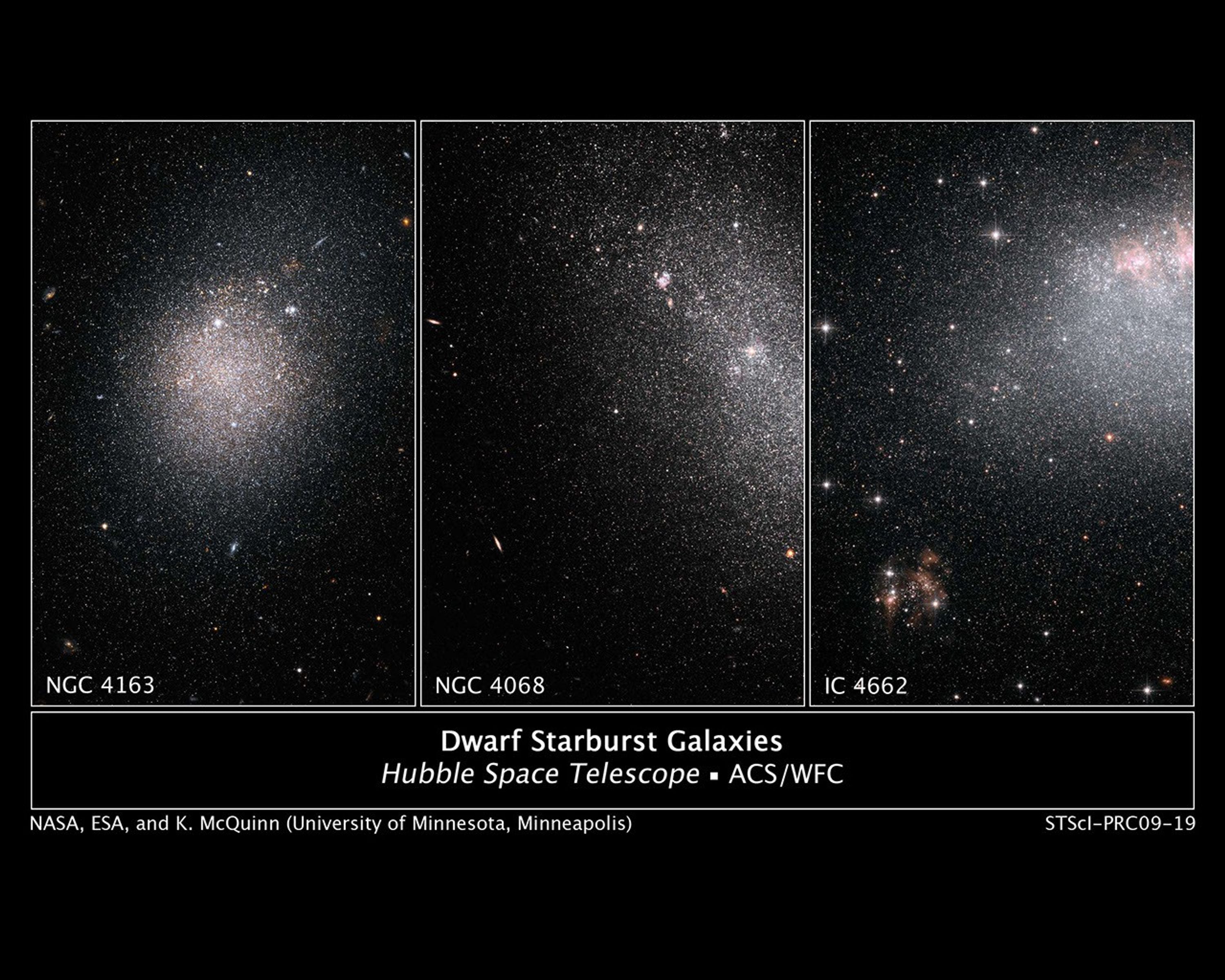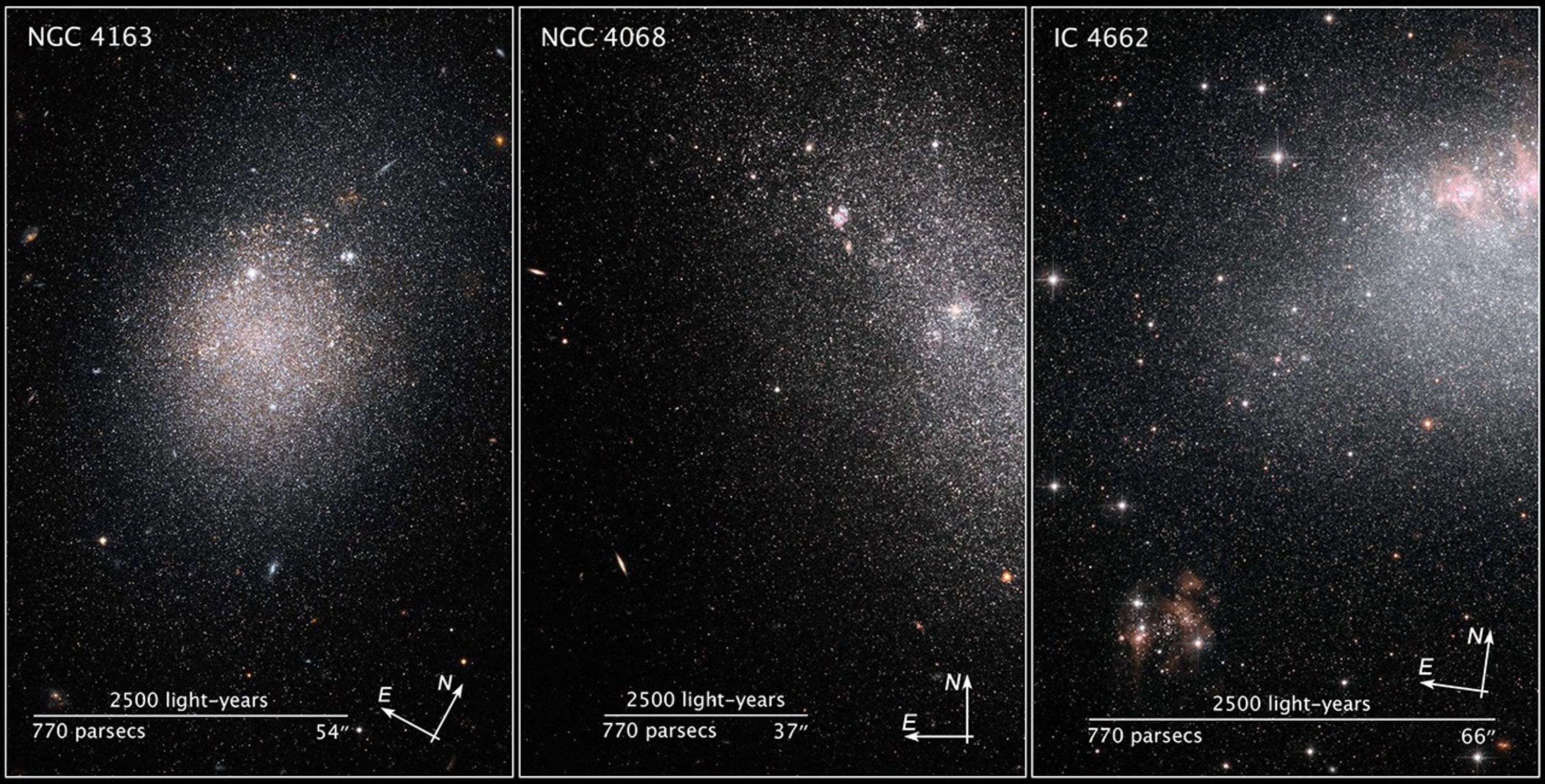1 min read
Hubble Spies a Frenzy of Star Birth in Dwarf Galaxies

These images, taken by NASA's Hubble Space Telescope, show myriad stars residing in the central regions of the three dwarf galaxies NGC 4163, NGC 4068, and IC 4662.
The bluish dots are younger stars; the reddish dots, older stars. The irregularly shaped red blobs in the images of NGC 4163 and IC 4662 are regions of current starburst activity. Starbursts are areas of intense star formation.
The three galaxies are part of a Hubble study of starbursts in nearby, small, or dwarf, galaxies. Based on this study, astronomers have found that starbursts continue 100 times longer than first thought, lasting 200 million to 400 million years. These galaxies show that starbursts are not isolated events, but sweep across a galaxy.
Each of the three starburst galaxies has a different shape. The collection of stars in NGC 4163 is more spherical, with a higher concentration of stars forming in the center. By contrast, the grouping of stars in NGC 4068 is more elongated and has fewer new stars than the other two galaxies. Astronomers think the starburst in this galaxy is ending. In the image of IC 4662 the clumpy red blobs peppered throughout the galaxy indicate active regions of star birth. One such region extends off the image's top, right edge. This galaxy exhibits the strongest star formation of the three galaxies in the study.
The distances of the galaxies range from 8 million to 14 million light-years away.
The images were taken in 2004 by the Advanced Camera for Surveys.
About the Data
- Data DescriptionData DescriptionProposal: A description of the observations, their scientific justification, and the links to the data available in the science archive.
Science Team: The astronomers who planned the observations and analyzed the data. "PI" refers to the Principal Investigator.The images were created from Hubble data from proposal 9771: I. Karachentsev (Russian Academy of Sciences, Special Astrophysical Observatory), B. Tully (University of Hawaii), V. Karachentseva (Kyiv University), A. Dolphin (Raytheon Company), S. Sakai (University of California, Los Angeles), E. Shaya (University of Maryland), and M. Sharina, L. Makarova, and D. Makarov (Russian Academy of Sciences, Special Astrophysical Observatory). The science team comprises: K. McQuinn and E. Skillman (University of Minnesota, Minneapolis), J. Cannon (Macalester College, MN), J. Dalcanton (University of Washington, Seattle), A. Dolphin (Raytheon Company), and D. Stark and D. Weisz (University of Minnesota, Minneapolis). - InstrumentInstrumentThe science instrument used to produce the data.HST>ACS
- Exposure DatesExposure DatesThe date(s) that the telescope made its observations and the total exposure time.January 18, 2004 (left), March 28, 2004 (center), and July 10, 2004 (right), Exposure Time: 35 minutes per image
- FiltersFiltersThe camera filters that were used in the science observations.F606W (R) and F814W (I)
- Object NameObject NameA name or catalog number that astronomers use to identify an astronomical object.NGC 4163, NGC 4068, IC 4662
- Object DescriptionObject DescriptionThe type of astronomical object.Starburst Galaxies
- Release DateApril 30, 2009
- Science ReleaseStarbursts in Dwarf Galaxies are a Global Affair
- Credit

These images are composites of several separate exposures made by the ACS instrument on the Hubble Space Telescope. Two filters were used to sample broad wavelength ranges for each image. The color results from assigning different hues (colors) to each monochromatic image. In this case, the assigned colors are orange/yellow for the I-band (F814W) and cyan/blue for the wide V-band (F606W) filter. The images have been further adjusted so the colors more closely resemble their true visual appearance, particularly the red hydrogen emission of the star-forming regions. Cyan: F606W (R) Yellow: F814W (I)

Share
Details
Claire Andreoli
NASA’s Goddard Space Flight Center
Greenbelt, Maryland
claire.andreoli@nasa.gov
































